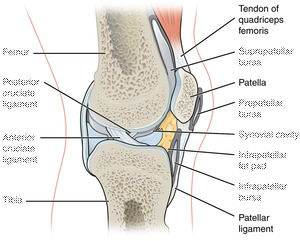
Illustration of knee joint identifying tendon, bone, and ligament
Even though their functions are different, ligaments and tendons are similar in many ways. They are two types of fibrous connective tissue. Both are essential to joint movement. Both can be vulnerable to acute or chronic injuries, as well as aging and arthritis. Both are commonly associated with sports injuries (e.g., sprained ankle) and injuries from falling (e.g., wrist sprain). And both can be painful and slow to recover from if torn, overworked, or overstretched.
So, how are they different?
Ligaments connect bones to bones.
Because their stretching ability is limited, ligaments are able to stabilize joints, prevent excessive movement, and protect against stress and forces that could be coming from various directions. They also prevent grinding between the bones and, amazingly, they contribute to “proprioception,” which is our body’s ability to sense movement, action, and location.
Tendons attach muscles to bones.
Tendons are tough, flexible bands that facilitate a more linear type of movement, transmitting the force of muscle contraction to associated bones. And this is what allows for your hands to grasp, your neck to rotate, and your knees to bend.
Tip for how to remember the difference between ligaments and tendons
Because they share similarities (and their names give no obvious indication of their purpose), it’s easy to confuse these two types of connective tissues. An easy tip for remembering the difference is that muscles are “tender.” Hence, ““tendons“” connect muscle to bone, while ligaments connect bone to bone.
Did you know?
We may be able to name knees, shoulders, wrists, and a couple other joints. But did you know we have around 350 joints (where two bones meet that move) throughout our bodies? Our bodies also contain approximately 900 ligaments and about 4,000 tendons. And while they are most associated with the joints, ligaments and tendons can be found elsewhere in the body. Tendons can be found connecting muscles to bones, muscles to muscles, and even muscles to connective tissue around other muscles. In addition to connecting bones to bones, ligaments can also be found supporting and stabilizing abdominal organs and breasts.
To differentiate between injuries to ligaments and tendons, an injured ligament is commonly called a sprain, while an injured tendon is commonly called a strain.
Can chiropractic treatments assist with ligament or tendon pain and injuries?
Depending on the type and severity of the injury and the person’s overall health, chiropractic care may offer effective, non-invasive ligament and tendon injury treatment options. Therapies might include:
Joint and soft tissue manipulation to reduce pain, inflammation, muscle tension, and dysfunction, improve mobility, and promote injured tissue healing.
Exercise recommendations to strengthen and improve the flexibility of muscles surrounding injured ligaments or tendons.
Posture, body mechanics, and ergonomic evaluation and correction guidance to prevent aggravating injured ligaments or tendons.
Coordinating care with other healthcare providers to develop a comprehensive treatment and recovery plan.
Looking for the best chiropractor in Omaha for the treatment of ligament or tendon pain?
Dr. Meyers at Back2Health in Omaha has been a practicing Doctor of Chiropractic Medicine since 1996. He incorporates holistic techniques in his healing practice, including spinal adjustments, soft tissue manipulation, and reducing muscle tension. These can help to prevent painful chronic issues, address imbalances, and promote the healing of knee injuries, elbow or shoulder injuries, or injuries to other joints.
Experience less pain and a quicker recovery. Contact Dr. Meyers at his midtown Omaha health and wellness office today.


